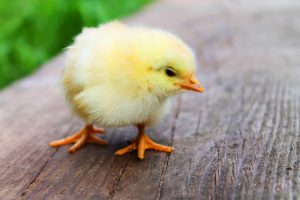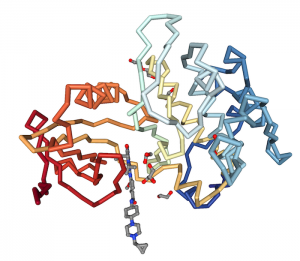Enter your address to receive notifications about new posts to your email.
Articles by Nicole Haloupek (78 results)
-
In the Year of the Rooster, a new chicken genome assembly is hatched
The chicken is one of humanity’s closest and oldest allies. With a worldwide population in the billions, this former jungle fowl is one of the most important domesticated animals on Earth. In the February issue of G3, Warren et al. further our understanding of this familiar bird, presenting a new and substantially improved chicken genome assembly…
-
Beyond stressed-out: the hypoxic response
Deep within a tumor, sequestered from an adequate blood supply, a cancer cell grows and multiplies. Far beneath Earth’s surface, a microbe lives and thrives in similarly low-oxygen conditions. Generally, oxygen depletion causes serious distress to aerobic organisms—what allows these life forms to survive? The cellular response to hypoxia is massive. Hypoxia alters the expression…
-
Pathogenic yeast uniquely resists toxicity of aggregation-prone proteins
Misfolded proteins can be so toxic that they cause cell death. At least nine neurodegenerative disorders are caused by misfolded proteins with expanded stretches of glutamine residues (polyQ tracts), including the invariably fatal Huntington’s disease. But some organisms are resistant to the harmful effects of these proteins. In the January issue of G3, Leach et…
-
Enhancer-promoter distance is a potent modulator of gene expression
To boost transcription of a target gene, enhancer sequences must make contact with the gene’s promoter. This crucial meeting is mediated by interacting proteins and the formation of chromatin loops that bring distant enhancers and promoters together. Although it’s clear that enhancers increase transcription this way, the primary mechanisms by which an enhancer’s target genes…
-
Fly model of traumatic brain injury untangles factors tied to mortality
Each year, emergency departments in the US treat almost 700,000 people for traumatic brain injury (TBI). The outcome depends largely on the severity and location of the injury, but these aren’t the only factors. Age also plays a role, with children often recovering more fully than do adults. The patient’s diet following the injury may…
-
New schizophrenia risk genes found by computational analysis
Symptoms of schizophrenia most commonly begin to creep up in young adulthood. Although genetics play a major role in this complex disorder, narrowing down the search for the genes involved has proven frustratingly difficult. Risk loci identified by genome-wide association studies (GWAS) may contain several genes, making it unclear which of these contribute to pathology.…
-
Dog pedigrees shed light on recombination
Recombination within the genome isn’t random. This swapping of DNA segments between one chromosome and its homolog preferentially affects specific genome regions called hotspots. These regions can have recombination rates many times higher than other areas of the genome, and the rapid shuffling of genetic information is thought to be important in evolution. The location…
-
Cold-loving fungi fight frostbite, but can’t take the heat
To the unaided eye, Antarctic soil and alpine glaciers may appear to be barren wastelands devoid of life. But some microbes call hostile habitats like these home. Research on one such organism, published in the latest issue of G3, reveals some of the mechanisms behind cold adaptation—and explains why these otherwise hardy creatures can’t survive…
-
Speed limits in bacterial factories
In the fast-paced life of a bacterium, the ability to manufacture proteins quickly and efficiently is crucial. In these organisms, mRNAs—the templates for building proteins—have a string of bases near the start called the Shine-Dalgarno (SD) sequence. This motif increases the rate at which translation is initiated. Some results suggest that the presence of SD…
-
Using yeast to expose cancer’s genetic vulnerabilities
Cancer profoundly scars the genome of an affected cell. Amplification and overexpression of chunks of DNA sequence are common—but it’s not always clear whether these changes are directly involved in the disease or byproducts of some other malfunction. Further complicating the search for treatments, many genes that are altered in cancer cells are involved in…
-
Can gene drives survive in the wild?
Efforts to engineer genomes in wild populations have huge potential for good—but the real world is more complicated than the lab. Until now, humans have never been able to seriously consider how to cheat evolution. But now that the CRISPR/Cas9 system has made genome editing easy and efficient, it might be possible to manipulate the…




![By Kelvinsong (Own work) [CC BY 3.0], via Wikimedia Commons. (Modified)](https://s36063.pcdn.co/wp-content/uploads/2017/01/rsz_transcription_factors-300x163.png)
![Traumatic brain injury is a risk for those who participate in contact sports, such as boxing and Muay Thai. By Eric Langley [CC BY 2.0], via Wikimedia Commons.](https://s36063.pcdn.co/wp-content/uploads/2016/12/npjxWixCqK0OdXXC-pic-300x199.jpg)
![A cloth embroidered by a person with schizophrenia. By cometstarmoon [CC BY 2.0], via Wikimedia Commons](https://s36063.pcdn.co/wp-content/uploads/2016/12/rsz_cloth_embroidered_by_a_schizophrenia_sufferer-300x225.jpg)

![By 23am.com (Antarctica Sailing Trip) [CC BY 2.0], via Wikimedia Commons.](https://s36063.pcdn.co/wp-content/uploads/2016/11/rsz_1antarctica_sailing_trip_pct283253678755pct29-300x201.jpg)
![By BMW Werk Leipzig (http://bmw-werk-leipzig.de) [CC BY-SA 2.0 de], via Wikimedia Commons](https://s36063.pcdn.co/wp-content/uploads/2016/11/rsz_bmw_leipzig_media_050719_download_karosseriebau_max-300x200.jpg)

